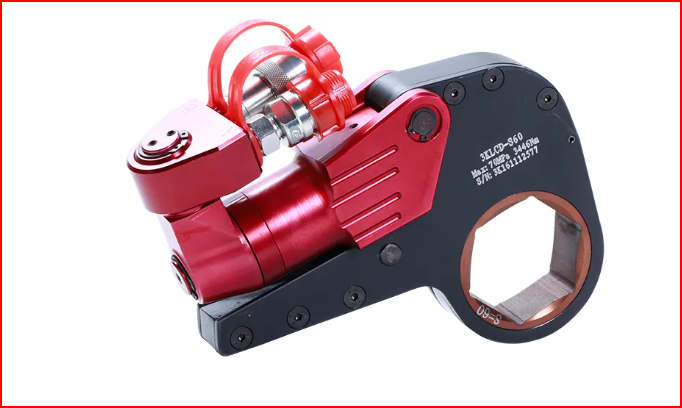Hydraulic torque wrench
A hydraulic torque wrench is a specialised tool used in industrial applications to apply a specific amount of torque (rotational force) to fasteners such as bolts and nuts. It uses hydraulic pressure to generate controlled rotational force, enabling accurate and controlled tightening or loosening of fasteners in various mechanical and construction tasks. Hydraulic torque wrenches are valued for their ability to achieve precise torque levels, ensuring proper assembly, structural integrity, and safe operation of equipment and structures.
The tool typically consists of a hydraulic cylinder, a reaction arm or head, and a hydraulic pump. The hydraulic pressure is directed to the cylinder, causing it to exert rotational force on the fastener. The reaction arm or head prevents the tool from rotating along with the fastener, ensuring that the applied force is directed solely onto the fastener.
Hydraulic torque wrenches are used in a wide range of industries including construction, manufacturing, oil and gas, power generation, and more. They are particularly crucial for applications where accurate and controlled torque is essential, such as assembling large machinery, tightening bolts on critical structures, and maintaining the integrity of joints in various engineering projects.
[edit] Related articles on Designing Buildings
Featured articles and news
Latest Build UK Building Safety Regime explainer published
Key elements in one short, now updated document.
UKGBC launch the UK Climate Resilience Roadmap
First guidance of its kind on direct climate impacts for the built environment and how it can adapt.
CLC Health, Safety and Wellbeing Strategy 2025
Launched by the Minister for Industry to look at fatalities on site, improving mental health and other issues.
One of the most impressive Victorian architects. Book review.
Common Assessment Standard now with building safety
New CAS update now includes mandatory building safety questions.
RTPI leader to become new CIOB Chief Executive Officer
Dr Victoria Hills MRTPI, FICE to take over after Caroline Gumble’s departure.
Social and affordable housing, a long term plan for delivery
The “Delivering a Decade of Renewal for Social and Affordable Housing” strategy sets out future path.
A change to adoptive architecture
Effects of global weather warming on architectural detailing, material choice and human interaction.
The proposed publicly owned and backed subsidiary of Homes England, to facilitate new homes.
How big is the problem and what can we do to mitigate the effects?
Overheating guidance and tools for building designers
A number of cool guides to help with the heat.
The UK's Modern Industrial Strategy: A 10 year plan
Previous consultation criticism, current key elements and general support with some persisting reservations.
Building Safety Regulator reforms
New roles, new staff and a new fast track service pave the way for a single construction regulator.
Architectural Technologist CPDs and Communications
CIAT CPD… and how you can do it!
Cooling centres and cool spaces
Managing extreme heat in cities by directing the public to places for heat stress relief and water sources.
Winter gardens: A brief history and warm variations
Extending the season with glass in different forms and terms.
Restoring Great Yarmouth's Winter Gardens
Transforming one of the least sustainable constructions imaginable.























